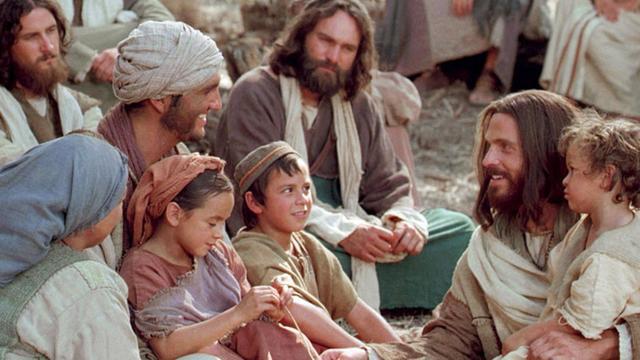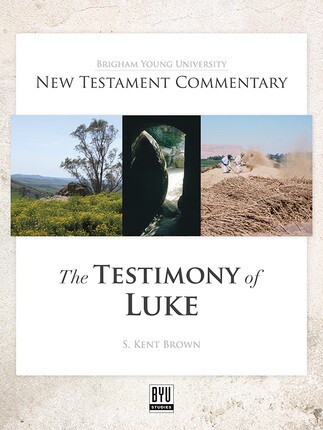This is the first article in a three-part series on Jesus Christ's teachings about families found in the Gospels. Read part two, "The Miracle of the Fishes + Other Ways Jesus Demonstrated His Focus on the Family," and part three, "How Jesus Honored His Family Despite Complicated Relationships."
Families, families, families. Everywhere I look in the Gospels, I see families. But some students of the Gospels see family as a topic only in Jesus’s isolated saying when family members came to visit Him as He was preaching to a crowd in Capernaum. We all know the story.
As Luke records the incident, Jesus’s mother and brothers found Him in a place so jammed with listeners that they “could not come at him for the press” (Luke 8:19). When someone told Jesus that His mother and brothers were standing outside, “desiring to see [him],” He responded memorably, “My mother and my brethren are these which hear the word of God, and do it” (8:20–21). We have to ask: Is this the end of the matter? For some, it is.
Homes and Families Transformed in the New Testament
However, I suggest that references to families, family relationships, and homes not only infuse the Gospel stories but jump out at us from Jesus’s teachings. Let us note a few of the obvious examples, then turn to some less obvious. We begin at the beginning—with Zacharias and Elisabeth.
1. Zacharias and Elisabeth
Luke’s narrative opens with a married couple. As the story rolls on, with the aid of heaven, Zacharias and Elisabeth, an older man and woman, became parents in a miraculous, unexpected way, welcoming a son into their home. Although the action began in the sanctuary of the temple with the appearance of the angel Gabriel to Zacharias the priest, it soon moved to the rooms of Zacharias’s home. In effect, that home became a spiritual powerhouse, a family space where God’s majesty was made visible in the lives of this man and woman.
For instance, Elisabeth, with her biological clock run out, became pregnant and gave birth to a son, notably a son of promise. Then to that home came the young Mary, who was already carrying her divine infant. At the moment of the meeting of the two women, at Elisabeth’s home, the Spirit of God rushed upon them in an outpouring of celestial grace and knowledge, allowing Elisabeth to share in the secret of the ages: Who the mother of the Messiah was to be—a stunning revelation to Elisabeth that occurred inside her home. Next, at the time of the naming and circumcision of Elisabeth’s child, Zacharias was miraculously released from his divinely imposed inabilities to hear and speak, and, driven by the Spirit of God, he prophesied about his infant son’s service as the Messiah’s herald (Luke 1).
Our conclusion? The first persons in Luke’s narrative constituted a family, a family whose members enjoyed an unprecedented outpouring of God’s Spirit and mercy. And virtually everything in the account occurred at their home.
2. Mary
The next revelation, after the one to Zacharias and its fulfillment in Elisabeth’s pregnancy, came to Mary, inside her home. Indeed, Luke’s language plainly leads us inside Mary’s parents’ home, for he writes that “the angel came in unto her” (Luke 1:28). Scriptural language affirms this observation (1 Ne. 3:11; Alma 15:5; 22:2; etc.). The Greek text also agrees that the angel entered a special, interior space.1 Mary’s surprise at the presence of a man—the angel—agrees with this observation, for the angel appeared in a place where she clearly thought she was safe from intruders. Beyond this, the angel’s appearance in her home subtly underscored the home and family as a proper place of spiritual inspiration and instruction. There is more.
3. The Leper and Others
In one of His early miracles, Jesus cleansed a leper (Luke 5:12–14). With a little effort, we look beyond the miracle and see, standing just out of sight, the man’s family. Luke recorded that the man was “full of leprosy” (5:12). Obviously, we are watching a man who has borne his affliction for a number of years, his affliction growing worse with time. This observation means that he and his family enjoyed almost no contact with one another throughout that period. In the larger society, he was banned from places of gathering and worship. In one transforming moment, Jesus restored this man to his family and home, to the synagogue and temple, healing him socially, religiously, and physically. Among the most prized possessions that returned to the man was his family. And his home.
We can make this point with any number of Jesus’s miracles, whether the healing of the paralyzed man (Luke 5:18–25), the raising of the only son of the widow in Nain (Luke 7:11–15), the healing of the Gadarene demoniac (Luke 8:26–39), or the woman who suffered from “an issue of blood” (Luke 8:43–48). In each case, these recipients of Jesus’s healing powers and others came from homes and families whose members had adjusted to the needs and limitations of the afflicted persons. When such individuals returned whole to their respective families, family members suddenly enjoyed a different, full relationship with the stricken one and even with one another. In making individuals whole, Jesus blessed homes and families in a new way. He knew this. These acts formed a part of His ministry both to individuals and, often through them, to families.
Parables Jesus Christ Taught About Family and the Home
When we turn to a sample of Jesus’s teachings on families, rather than turning to something obvious, such as the parable of the prodigal son, let us take up something more subtle. A first sample appears in chapter 11 of Luke. The matter of family and home arises in Jesus’s response to critics who, grabbing at straws, claimed that Jesus was casting out “devils through Beelzebub, the chief of the devils” (Luke 11:15). At the same time, Jesus was answering others who sought “a sign from heaven” (Luke 11:16). Their criticism and misguided seeking led to a very interesting reply from Jesus that drew on three examples having to do with homes.
1. A Kingdom Divided
In the first, Jesus nodded toward a divided kingdom: “Every kingdom divided against itself is brought to desolation,” including Satan’s kingdom. Jesus then pointed to “a house divided against a house” (Luke 11:17). Jesus’s pictures of a divided kingdom and a divided house have to do with divisions within them. In the case of the house, it was the family that was in peril. Why? Because the term house means more than the physical building. It also has to do with household or family, a meaning that lies in the Greek and Hebrew words for house. Taken in this sense, Jesus’s statement pertained to the unwelcome prospect of enfeebling family divisions, which He here warned against.
2. A Strong Man’s Palace
Jesus next brought up a second example, this one of “a strong man.” While the strong man’s “palace” (a better translation is the “courtyard” that stands in the middle of his home) was secure, and “his goods are in peace” (Luke 11:21), all must have been well at home and in the countryside. But this situation quickly crumbled when a person “stronger than he” came and dispossessed him of his house and other property. All commentators agree that, because in these verses Jesus was warning about the devil, the strong man is the devil and the stronger is Jesus Himself.2 Jesus’s example implies that the devil can settle into a home, here envisioned through its courtyard, and remain in charge without challenge. This circumstance changed only when the Lord showed up, moved him out, and freed his “goods,” that is his captive souls (Greek ta hyparchonta) who were residing in the home.3
In a third example, Jesus drew his hearers’ attention to an “unclean spirit” who, when forced “out of a man,” walked “through dry places, seeking rest.” When the spirit found no resting place, it returned to “my house” (Luke 11:24; note the possessive) and found the house “swept and garnished.” Thereafter, it recruited “seven other spirits more wicked than himself” and settled back into its former house. Jesus concluded that “the last state of that man is worse than the first” (Luke 11:25–26). The lesson? A home comfortably “swept and garnished” fails as a person’s refuge from harmful influences if nothing has been put in their place to resist wickedness or to take the place of earlier enticing evil.
In all three illustrations, Jesus’s focus rested on the home and on those who resided in it. Regrettably, lying amidst the banter between Jesus and His opponents and rising within His sayings to them, the home stood in close proximity to the world of evil, so close that this world of evil formed a crippling intrusion into the home and, in Jesus’s words, must be overcome and separated from it. In effect, without a conquering effort, evil can make its permanent camp within a person’s home. Moreover, the stories and sayings packed into these verses illuminate Jesus’s interest in the home, underscoring its proper place as a refuge from evil, with His help as the stronger one.
Jesus Christ as the Foundation of Our Homes
Another teaching arises within Jesus’s Sermon on the Plain. At the end of this sermon, which takes up most of chapter six in Luke’s Gospel, we hear His raised voice: “Whosoever cometh to me, and heareth my sayings, and doeth them, I will shew you to whom he is like.”
He then went on to illustrate:
“He is like a man which built an house, and digged deep, and laid the foundation on a rock: and when the flood arose, the stream beat vehemently upon that house, and could not shake it: for it was founded upon a rock” (6:47–48).
The image of building, which Jesus appealed to here and elsewhere (see Matt. 7:24–27; Luke 20:17; 3 Ne. 11:39; 14:24–27), is one that cuts across geographical settings, warning that a builder must be wary of seasonal rains and floods pouring through river valleys. The point was surely not lost on the gathered throng who were assembled only a few miles west of the Golan Heights, whose valleys and flatlands fill with water during the rainy season. The second and more important element for our interests has to do with the house, essentially a person’s household or family (Greek oikia; Hebrew bayit). In this common, figurative sense, Jesus declared that a parent is obliged to create a home that rests on a sure foundation, on bedrock, which foundation is Himself.
In sum, with a little digging we can unearth many instances wherein Jesus’s interests and concerns for families and homes appears just beneath the surface of the New Testament Gospels. Those concerns range from blessing families through healing individuals to teaching about the sanctity of the home by keeping it free of the devil’s influences to teaching the importance of parents’ efforts to set sure foundations in their homes.
Lead image from ChurchofJesusChrist.org
For further information, see S. Kent Brown, The Testimony of Luke, The BYU New Testament Commentary [Provo, Utah: BYU Studies, 2015.]
1. Gerhard Kittel and Gerhard Friedrich, eds., Theological Dictionary of the New Testament, 9 vols., trans. Geoffrey W. Bromiley (Grand Rapids, MI: Eerdmans, 1964–74), 2:676–77.
2. For example, James E. Talmage, Jesus the Christ (Salt Lake City: Deseret Book, 1963), 268; Leon Morris, Luke: An Introduction and Commentary, rev. ed. (Grand Rapids, MI: Eerdmans, 1988), 217.
3. Kittel and Friedrich, eds., Theological Dictionary of the New Testament, 3:399–401.



